A Case Report of Zygomatic Fracture Reconstruction: Evaluation with Orbital Measurements and Models Registration
Abstract
:1. Introduction
2. Case Presentation
2.1. Study Design
2.2. Skull Model Generation
2.3. PSI Design
2.4. Virtual Planning of Patients-Specific Implants
2.5. Manufacturing of Patient-Specific Implants and Surgical Procedure
2.6. Calculation of Orbital Measurements
2.7. Models Registration
3. Results
3.1. Post-Operative Clinical Evaluation
3.2. Pre- and Postoperative Orbital Measurements
3.3. Evaluation of Clinical Matching
4. Discussion
5. Conclusions
Author Contributions
Funding
Institutional Review Board Statement
Informed Consent Statement
Data Availability Statement
Conflicts of Interest
References
- Goupil, M.T.; Ferneini, E.M. Is Cosmetic Surgery Ethical? Am. J. Cosmet. Surg. 2019, 36, 109–110. [Google Scholar] [CrossRef]
- van Gijn, D.R.; Dunne, J. The Orbit and Its Contents. In Oxford Handbook of Head and Neck Anatomy; Standring, S., Eccles, S., Eds.; Oxford University Press: Oxford, UK, 2022; pp. 349–396. ISBN 9780198767831. [Google Scholar]
- Soh, H.Y.; Sun, Q.; Hu, L.-H.; Wang, Y.; Mao, C.; Peng, X.; Zhang, W.-B. Accuracy of Globe-Sparing Orbital Reconstruction Using Individually Bent Titanium Mesh: A Comparative Study. J. Plast. Reconstr. Aesthet. Surg. 2022, 75, 1971–1978. [Google Scholar] [CrossRef] [PubMed]
- Chepurnyi, Y.; Chernohorskyi, D.; Zhukovtceva, O.; Poutala, A.; Kopchak, A. Automatic Evaluation of the Orbital Shape after Application of Conventional and Patient-Specific Implants: Correlation of Initial Trauma Patterns and Outcome. J. Oral Biol. Craniofac. Res. 2020, 10, 733–737. [Google Scholar] [CrossRef] [PubMed]
- Lv, M.; Yang, X.; Gvetadze, S.R.; Gupta, A.; Li, J.; Sun, J. Accurate Reconstruction of Bone Defects in Orbital-Maxillary-Zygomatic (OMZ) Complex with Polyetheretherketone (PEEK). J. Plast. Reconstr. Aesthet. Surg. 2022, 75, 1750–1757. [Google Scholar] [CrossRef] [PubMed]
- Nguyen, E.; Lockyer, J.; Erasmus, J.; Lim, C. Improved Outcomes of Orbital Reconstruction with Intraoperative Imaging and Rapid Prototyping. J. Oral Maxillofac. Surg. 2019, 77, 1211–1217. [Google Scholar] [CrossRef]
- Zeller, A.-N.; Neuhaus, M.T.; Gessler, N.; Skade, S.; Korn, P.; Jehn, P.; Gellrich, N.-C.; Zimmerer, R.M. Self-Centering Second-Generation Patient-Specific Functionalized Implants for Deep Orbital Reconstruction. J. Stomatol. Oral Maxillofac. Surg. 2021, 122, 372–380. [Google Scholar] [CrossRef]
- Zherka, I.Y.; Zhiliayeva, K.P.; Naumenka, L.V.; Kaliadzich, Z.V.; Ena, D.L.; Zamotin, I.D.; Arlou, P.A. The Application of Navigation System Based on the Augmented Reality Technology for the Surgical Treatment of Orbital Tumors. Nov. Khirurgii 2021, 29, 67–74. [Google Scholar] [CrossRef]
- Kang, Y.-F.; Liang, J.; He, Z.; Zhang, L.; Shan, X.-F.; Cai, Z.-G. Orbital Floor Symmetry after Maxillectomy and Orbital Floor Reconstruction with Individual Titanium Mesh Using Computer-Assisted Navigation. J. Plast. Reconstr. Aesthet. Surg. 2020, 73, 337–343. [Google Scholar] [CrossRef]
- Darwich, A.; Attieh, A.; Khalil, A.; Szávai, S.; Nazha, H. Biomechanical Assessment of Orbital Fractures Using Pa-Tient-Specific Models and Clinical Matching. J. Stomatol. Oral Maxillofac. Surg. 2021, 122, e51–e57. [Google Scholar] [CrossRef]
- Callahan, A.B.; Campbell, A.A.; Petris, C.; Kazim, M. Low-Cost 3D Printing Orbital Implant Templates in Secondary Orbital Reconstructions. Ophthal. Plast. Reconstr. Surg. 2017, 33, 376–380. [Google Scholar] [CrossRef]
- Day, K.M.; Phillips, P.M.; Sargent, L.A. Correction of a Posttraumatic Orbital Deformity Using Three-Dimensional Modeling, Virtual Surgical Planning with Computer-Assisted Design, and Three-Dimensional Printing of Custom Implants. Craniomaxillofac. Trauma Reconstr. 2018, 11, 078–082. [Google Scholar] [CrossRef] [PubMed]
- Vehmeijer, M.; van Eijnatten, M.; Liberton, N.; Wolff, J. A Novel Method of Orbital Floor Reconstruction Using Virtual Planning, 3-Dimensional Printing, and Autologous Bone. J. Oral Maxillofac. Surg. 2016, 74, 1608–1612. [Google Scholar] [CrossRef] [PubMed]
- Habib, L.A.; Yoon, M.K. Patient Specific Implants in Orbital Reconstruction: A Pilot Study. Am. J. Ophthalmol. Case Rep. 2021, 24, 101222. [Google Scholar] [CrossRef] [PubMed]
- Mahendru, S.; Jain, R.; Garg, S.; Singh, H.; Jain, A.; Sarin, D.; Khazanchi, R.K. “Hybrid Reconstruction” for Zygomaticomaxillary Complex Defect Using CAD/CAM: A Case Report: A Case Report. Plast. Reconstr. Surg. Glob. Open 2020, 8, e3140. [Google Scholar] [CrossRef]
- Chepurnyi, Y.; Chernogorskyi, D.; Kopchak, A.; Petrenko, O. Clinical Efficacy of Peek Patient-Specific Implants in Orbital Reconstruction. J. Oral Biol. Craniofac. Res. 2020, 10, 49–53. [Google Scholar] [CrossRef] [PubMed]
- Falkhausen, R.; Mitsimponas, K.; Adler, W.; Brand, M.; von Wilmowsky, C. Clinical Outcome of Patients with Orbital Fractures Treated with Patient Specific CAD/CAM Ceramic Implants—A Retrospective Study. J. Craniomaxillofac. Surg. 2021, 49, 468–479. [Google Scholar] [CrossRef]
- Rajantie, H.; Kaukola, L.; Snäll, J.; Roine, R.; Sintonen, H.; Thorén, H. Health-Related Quality of Life in Patients Surgically Treated for Orbital Blow-out Fracture: A Prospective Study. Oral Maxillofac. Surg. 2021, 25, 373–382. [Google Scholar] [CrossRef] [PubMed]
- Darwich, M.A.; Darwich, K.; Yousof, K.; Szávai, S.; Nazha, H.M.; Juhre, D. Computer-Assisted Reconstruction of an Orbital Trauma Case Treated with a Patient-Specific Titanium Prosthesis. Cosmetics 2023, 10, 52. [Google Scholar] [CrossRef]
- Kim, H.J.; Moon, S.Y. The Deep Circumflex Iliac Artery Flap for Mandibular Reconstruction and Donor Site Reconstruction with a Patient-Specific Implant: A Case Report. Appl. Sci. 2020, 10, 1587. [Google Scholar] [CrossRef]
- Azarmehr, I.; Stokbro, K.; Bell, R.B.; Thygesen, T. Contemporary Techniques in Orbital Reconstruction: A Review of the Literature and Report of a Case Combining Surgical Navigation, Computer-Aided Surgical Simulation, and a Patient-Specific Implant. J. Oral Maxillofac. Surg. 2020, 78, 594–609. [Google Scholar] [CrossRef]
- Malesza, M.; Wittmann, E. Acceptance and Intake of COVID-19 Vaccines among Older Germans. J. Clin. Med. 2021, 10, 1388. [Google Scholar] [CrossRef] [PubMed]
- Majeed, N.F.; Chang, J.E.; Yarlagadda, B.B.; Small, J.E. Angioedema in Lymphoproliferative Disease: A Case Report. J. Oral Maxillofac. Surg. Med. Pathol. 2021, 33, 362–365. [Google Scholar] [CrossRef]
- Lin, Y.; Zhou, H.; Lv, K.; Li, Z.; Li, Z. Design and Use of a Pair of Computer-Designed Surgical Templates in Reduction of a Comminuted Zygomatic Arch Fracture. J. Craniofac. Surg. 2022, 33, 2606–2608. [Google Scholar] [CrossRef] [PubMed]
- Costan, V.V.; Sulea, D.; Popescu, E. Associated Fracture of the Zygomatic Bone and Mandibular Coronoid Process. Int. J. Oral Maxillofac. Surg. 2017, 46, 258. [Google Scholar] [CrossRef]
- Gong, J.; Zhang, W.; Zhao, R.; Zhang, W.; Wang, B.; Ma, D. The Role of Intraoperative Navigation in Surgical Treatment of Unilateral Zygomatic Complex Fractures: A Systematic Review and Meta-Analysis. J. Oral Maxillofac. Surg. 2023. [Google Scholar] [CrossRef]
- Panneerselvam, E.; Balasubramanian, S.; Kempraj, J.; Babu, V.R.; Raja, V.B.K.K. Management of Zygomatic Arch Fractures by Intraoral Open Reduction and Transbuccal Fixation: A Technical Note. Craniomaxillofac. Trauma Reconstr. 2020, 13, 130–132. [Google Scholar] [CrossRef] [PubMed]
- Lôbo, M.V.; Nascimento, Y.L.; de Andrade, T.I.; Pontes, K.T.; de Andrade, J.S.; dos Barbosa, L.N.S.; de Souza, I.C.; Brainer, D.L.B. Closed Reduction with Minimal Accesses for Treating Isolated Zygomatic Arch Fractures: Case Series. Res. Soc. Dev. 2021, 10, e30810615792. [Google Scholar] [CrossRef]
- Salma, R.G.; Almutairi, K.M.; Alalmai, M.I. The Clinical Course of Diplopia Associated with Zygomaticomaxillary Complex Fractures before and after Surgery. J. Oral Maxillofac. Surg. Med. Pathol. 2018, 30, 191–196. [Google Scholar] [CrossRef]
- Feng, F.; Wang, H.; Guan, X.; Tian, W.; Jing, W.; Long, J.; Tang, W.; Liu, L. Mirror Imaging and Preshaped Titanium Plates in the Treatment of Unilateral Malar and Zygomatic Arch Fractures. Oral Surg. Oral Med. Oral Pathol. Oral Radiol. Endod. 2011, 112, 188–194. [Google Scholar] [CrossRef]
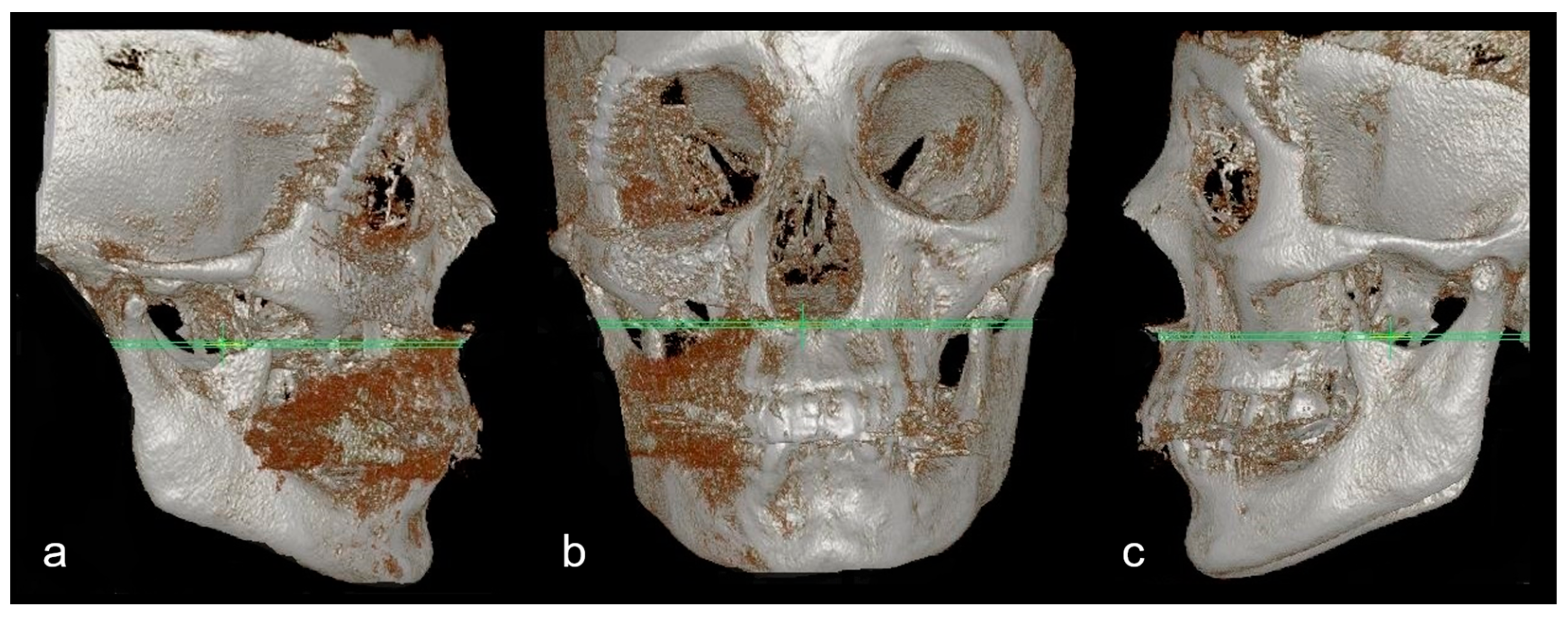
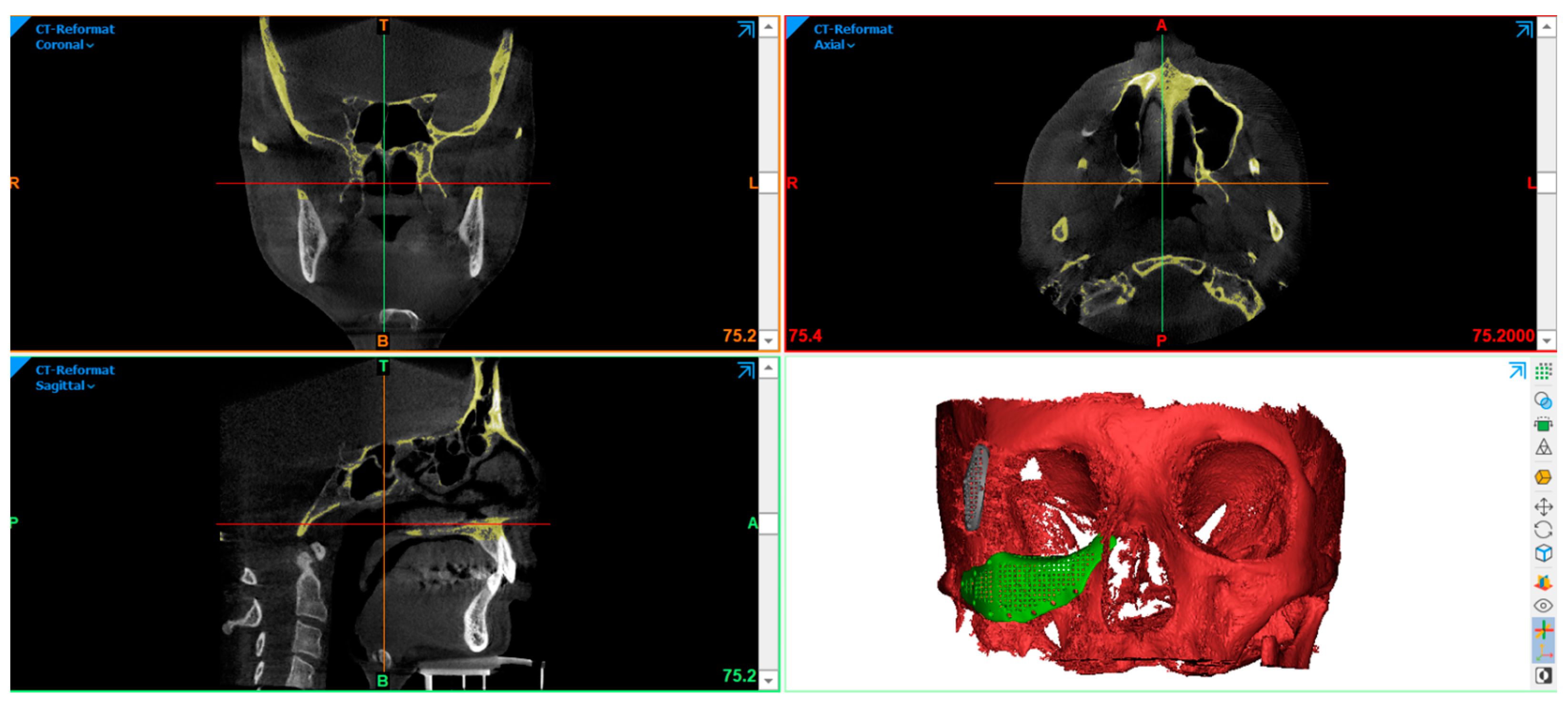
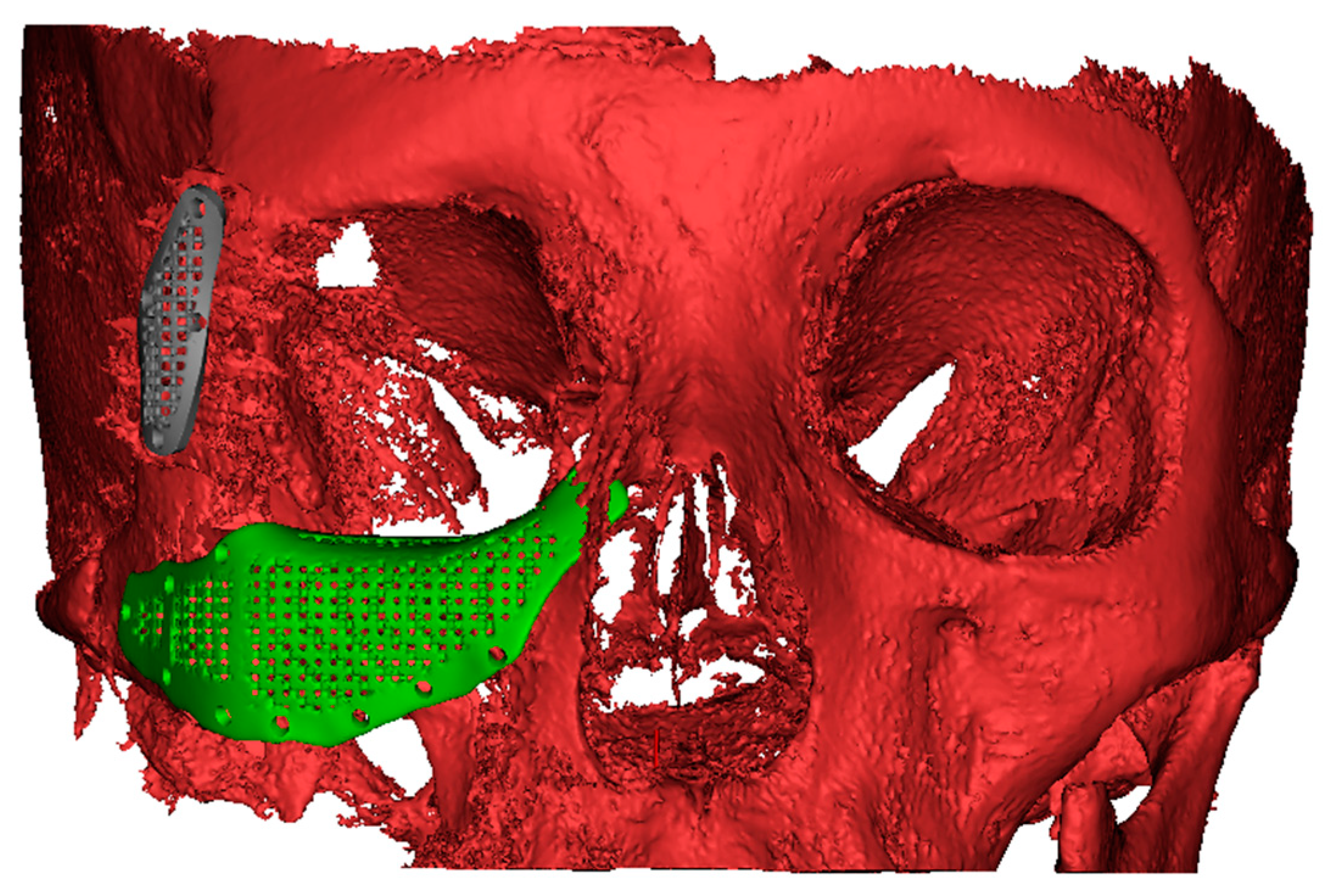

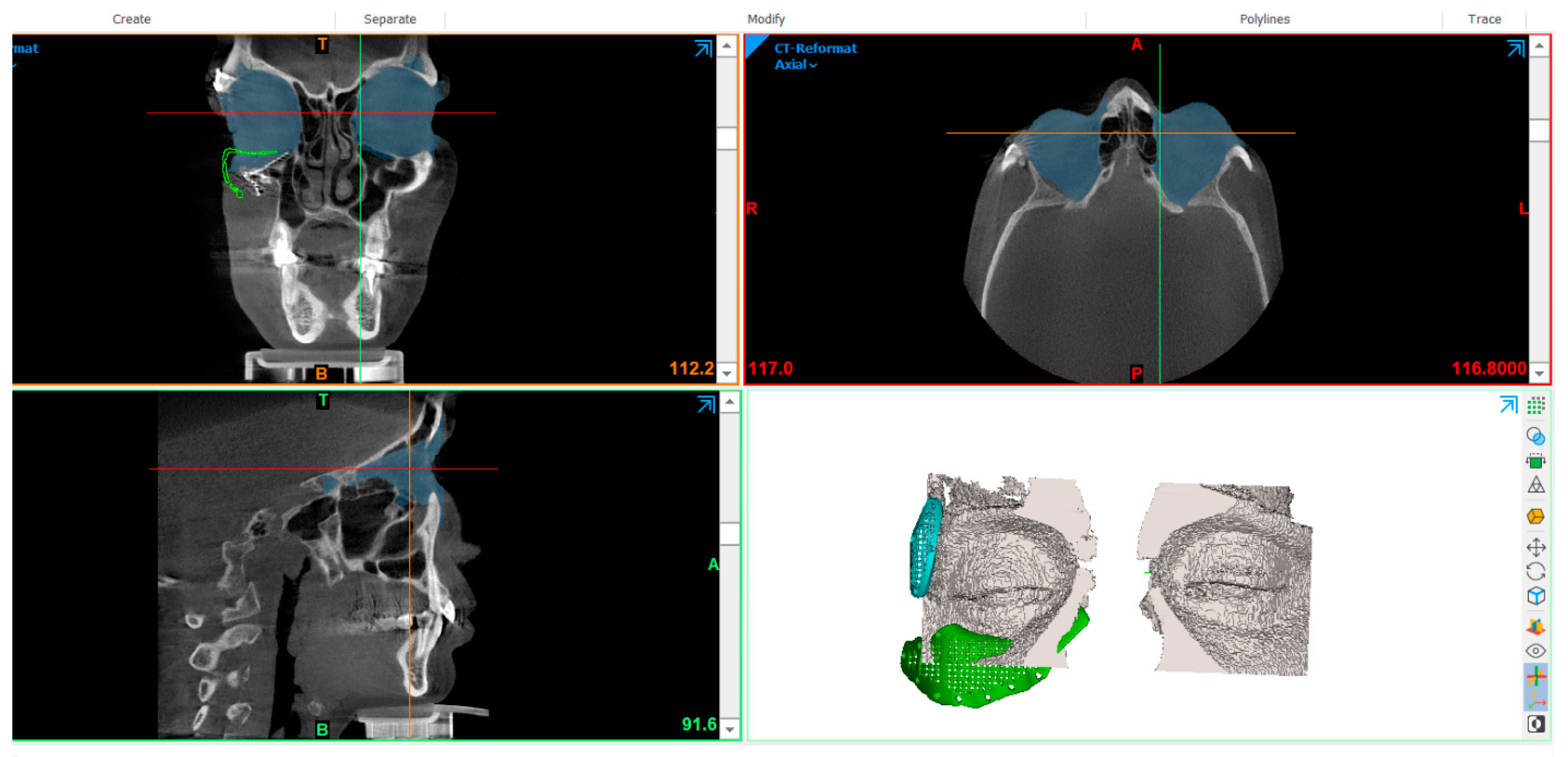
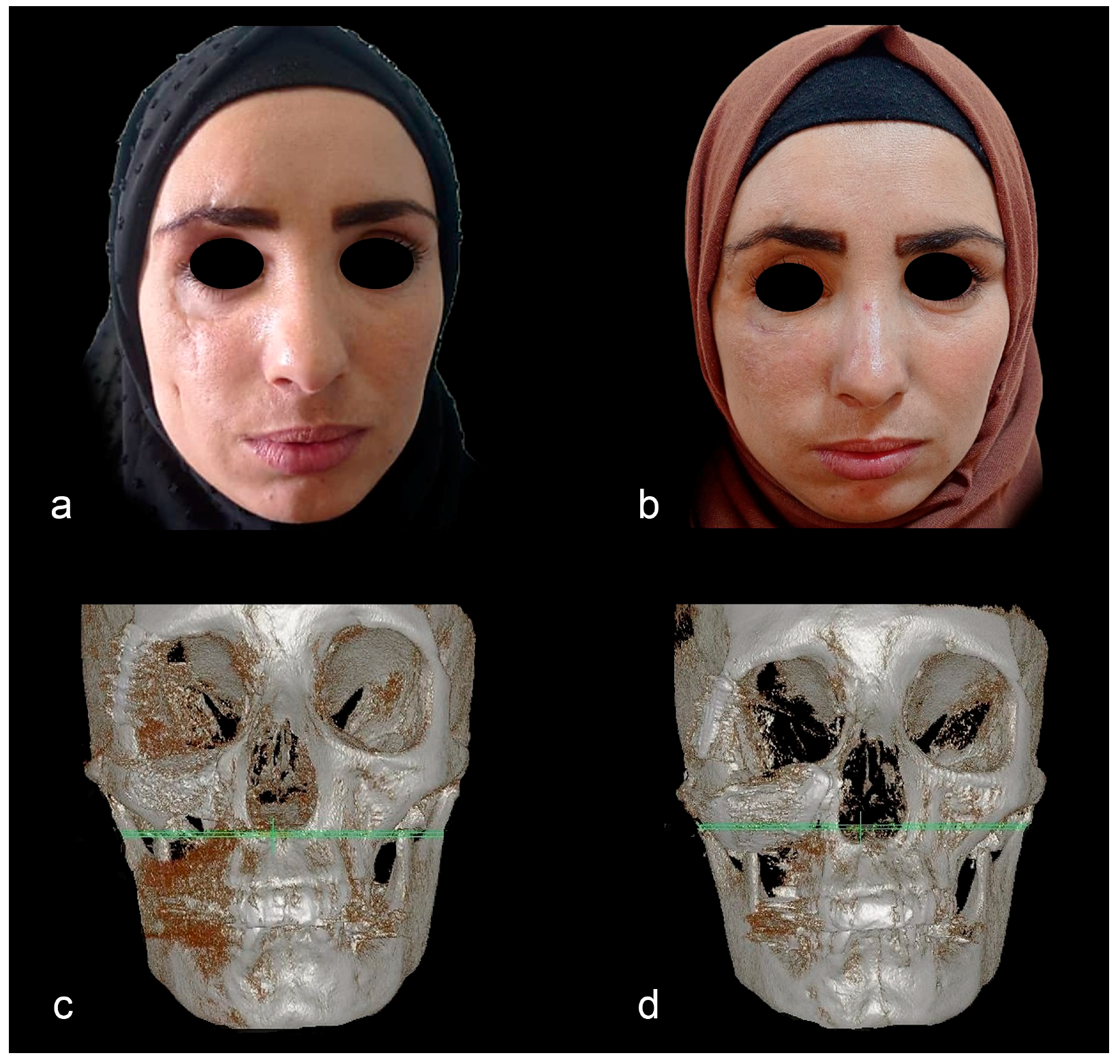
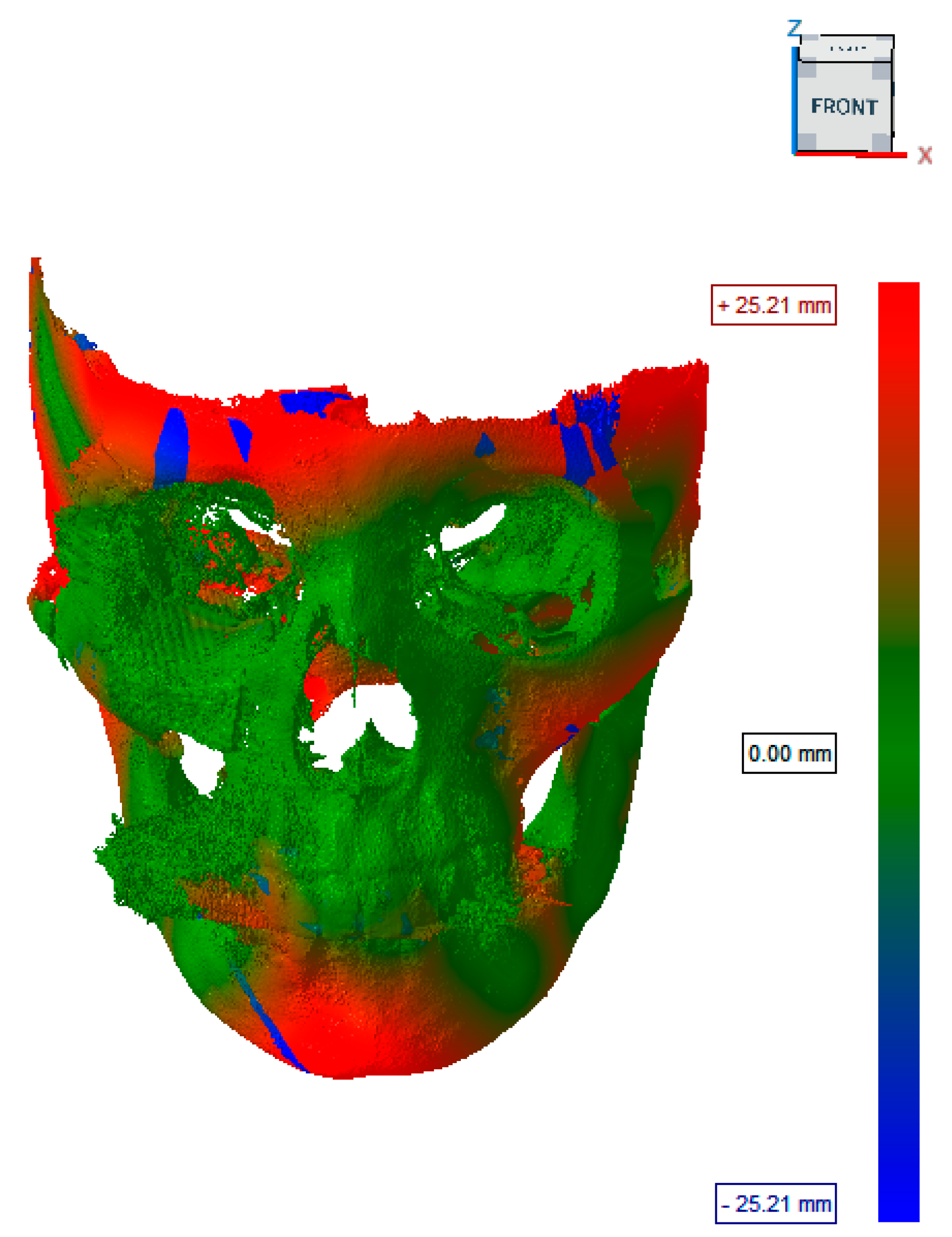
| Frontal Area [mm2] | Perimeter [mm] | Depth [mm] | Volume [mm3] | |
|---|---|---|---|---|
| Before Surgery | ||||
| Fractured | 1138.61 | 132.61 | 35.08 ± 2.53 | 25,621.6 |
| Contralateral | 1060.79 | 122.53 | 37.66 ± 1.67 | 26,727.1 |
| After Surgery | ||||
| Fractured | 1142.32 | 125.62 | 36.22 ± 2.42 | 26,247.2 |
| Contralateral | 1082.30 | 122.53 | 37.66 ± 1.67 | 26,543.4 |
| Mean | Std. Deviation | Sig. (2-Tailed) | ||
|---|---|---|---|---|
| Pair 1 | VolumeC–VolumeF | 700.85000 | 467.24957 | 0.058 |
| Pair 2 | AreaC–AreaF | −68.92000 | 10.27683 | <0.001 |
| Pair 3 | PerimeterC–PerimeterF | −6.58500 | 4.03568 | 0.047 |
Disclaimer/Publisher’s Note: The statements, opinions and data contained in all publications are solely those of the individual author(s) and contributor(s) and not of MDPI and/or the editor(s). MDPI and/or the editor(s) disclaim responsibility for any injury to people or property resulting from any ideas, methods, instructions or products referred to in the content. |
© 2023 by the authors. Licensee MDPI, Basel, Switzerland. This article is an open access article distributed under the terms and conditions of the Creative Commons Attribution (CC BY) license (https://creativecommons.org/licenses/by/4.0/).
Share and Cite
Yousof, K.; Darwich, M.A.; Darwich, K.; Alassah, G.; Imran, A.; Nazha, H.M. A Case Report of Zygomatic Fracture Reconstruction: Evaluation with Orbital Measurements and Models Registration. Appl. Sci. 2023, 13, 6154. https://doi.org/10.3390/app13106154
Yousof K, Darwich MA, Darwich K, Alassah G, Imran A, Nazha HM. A Case Report of Zygomatic Fracture Reconstruction: Evaluation with Orbital Measurements and Models Registration. Applied Sciences. 2023; 13(10):6154. https://doi.org/10.3390/app13106154
Chicago/Turabian StyleYousof, Khalil, Mhd Ayham Darwich, Khaldoun Darwich, Ghina Alassah, Ahmed Imran, and Hasan Mhd Nazha. 2023. "A Case Report of Zygomatic Fracture Reconstruction: Evaluation with Orbital Measurements and Models Registration" Applied Sciences 13, no. 10: 6154. https://doi.org/10.3390/app13106154
APA StyleYousof, K., Darwich, M. A., Darwich, K., Alassah, G., Imran, A., & Nazha, H. M. (2023). A Case Report of Zygomatic Fracture Reconstruction: Evaluation with Orbital Measurements and Models Registration. Applied Sciences, 13(10), 6154. https://doi.org/10.3390/app13106154







